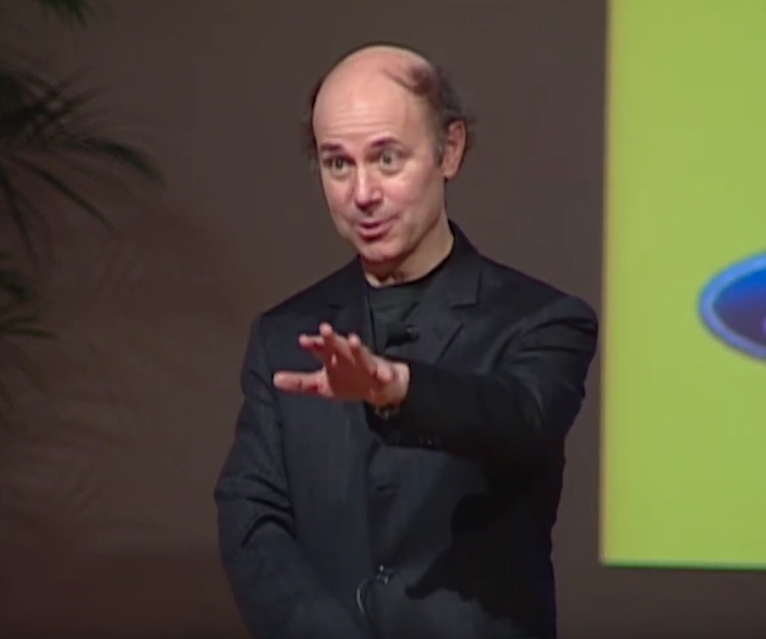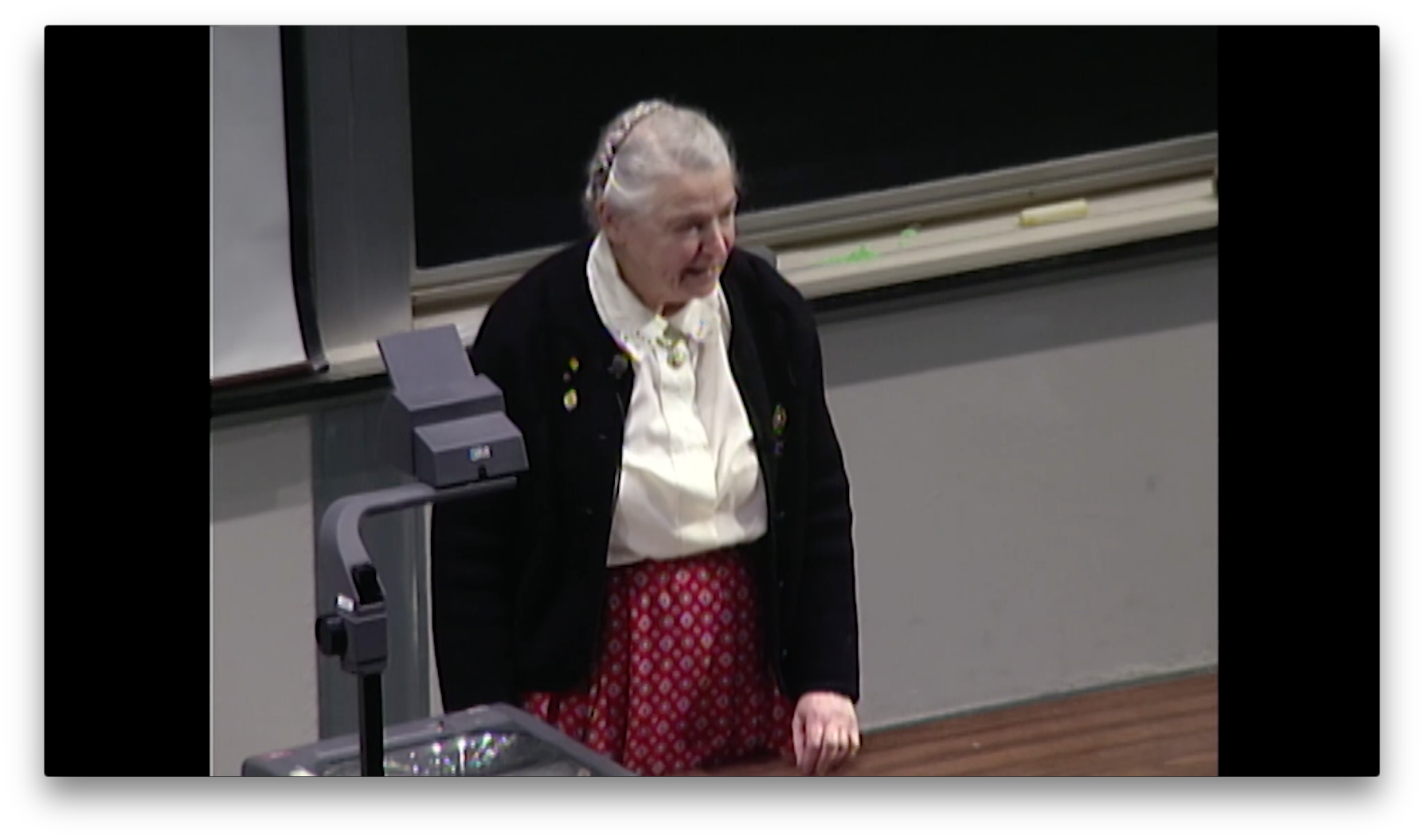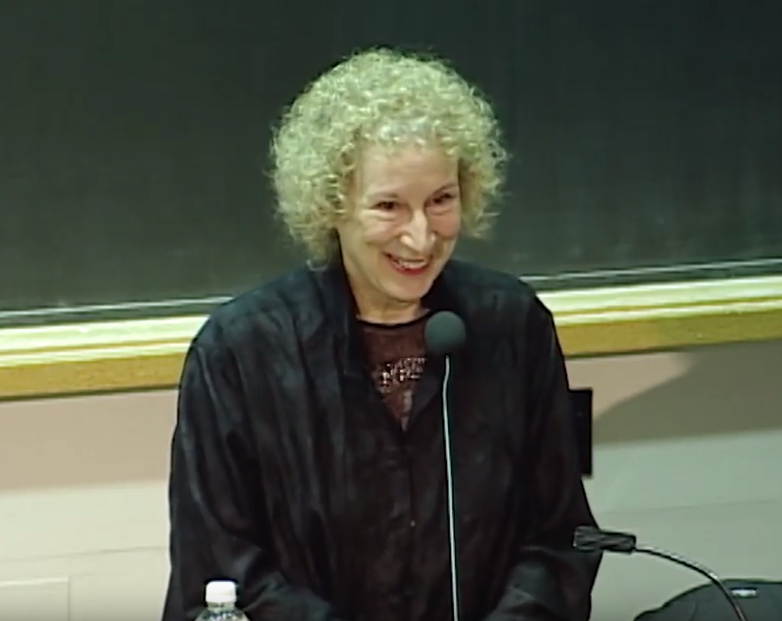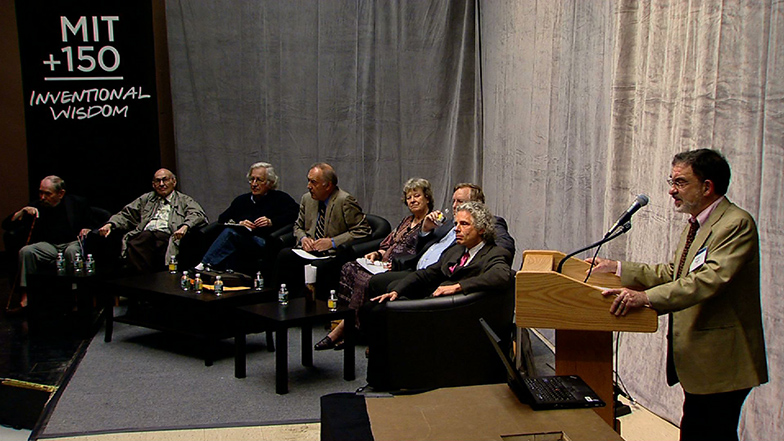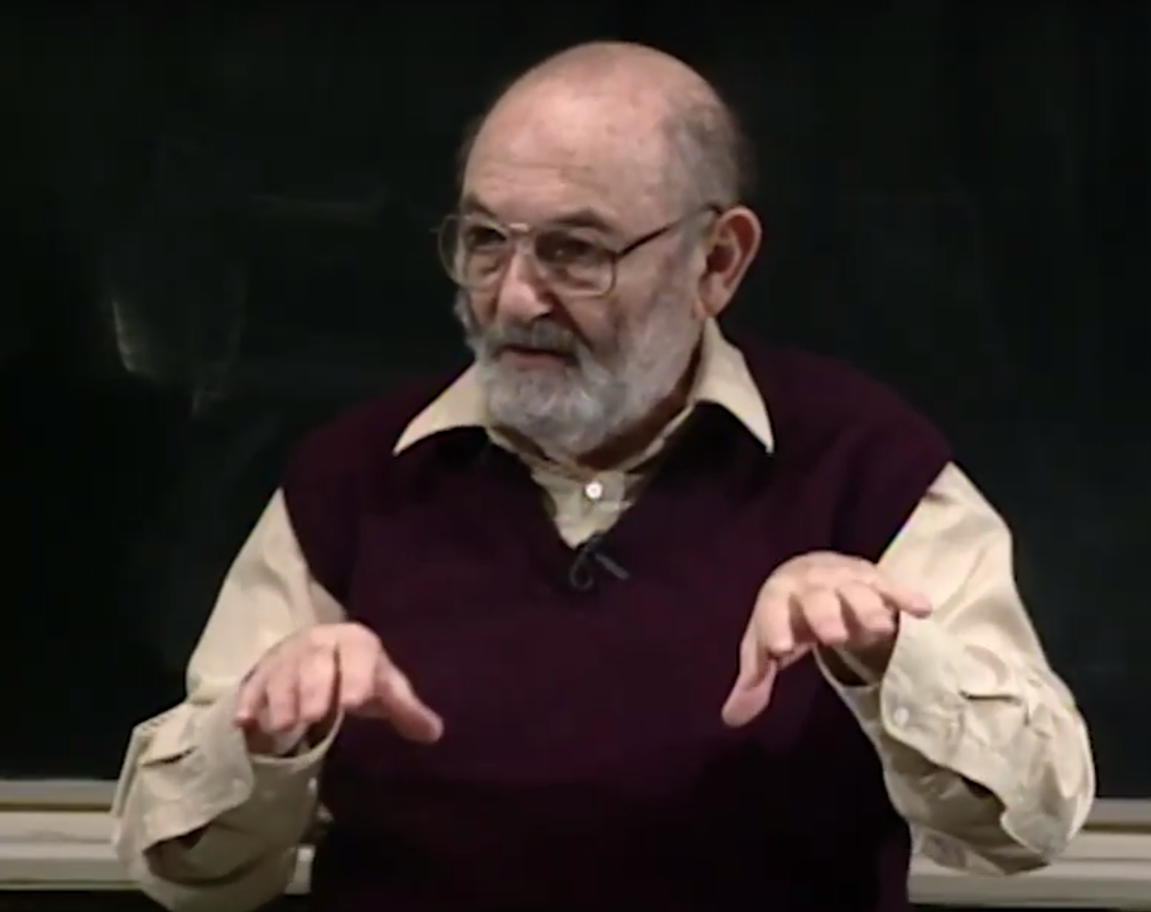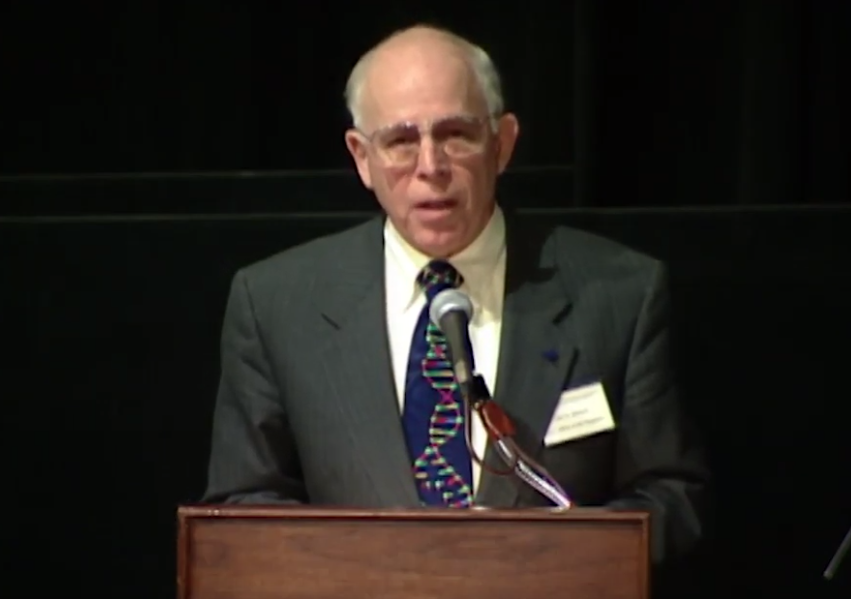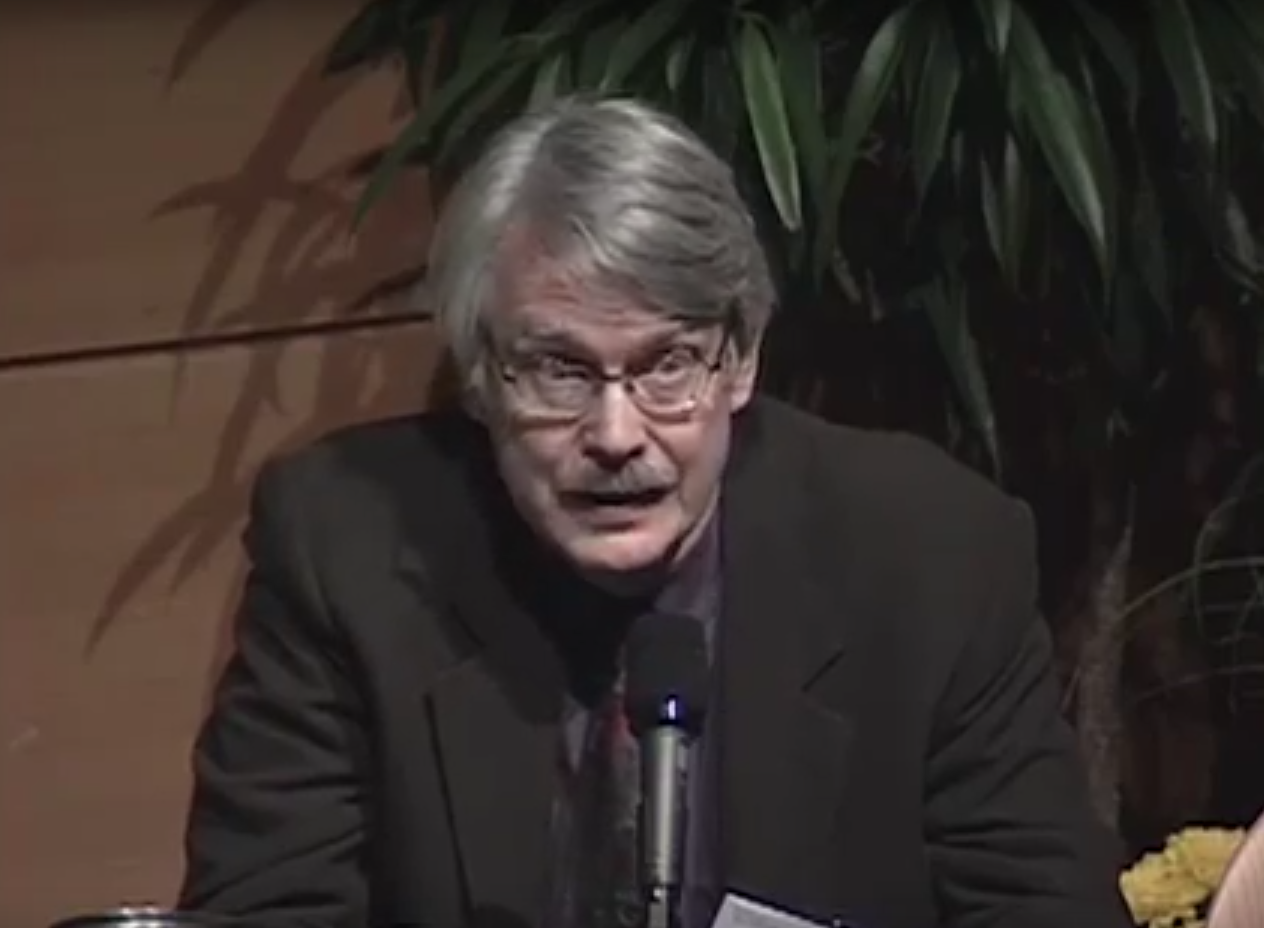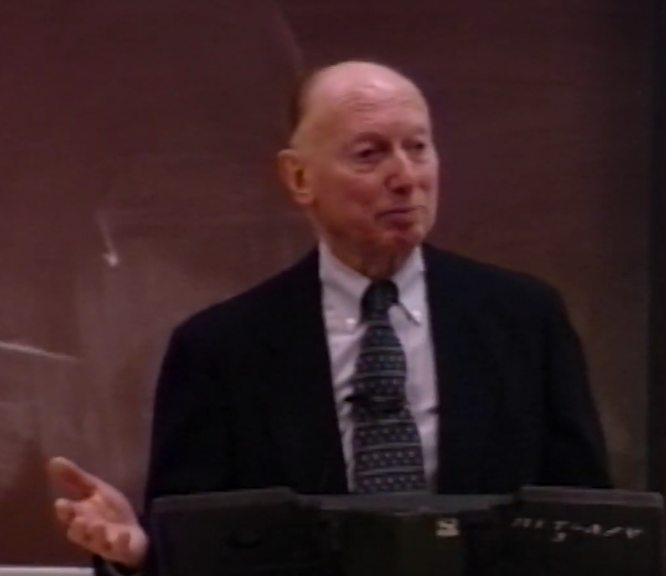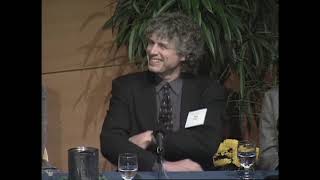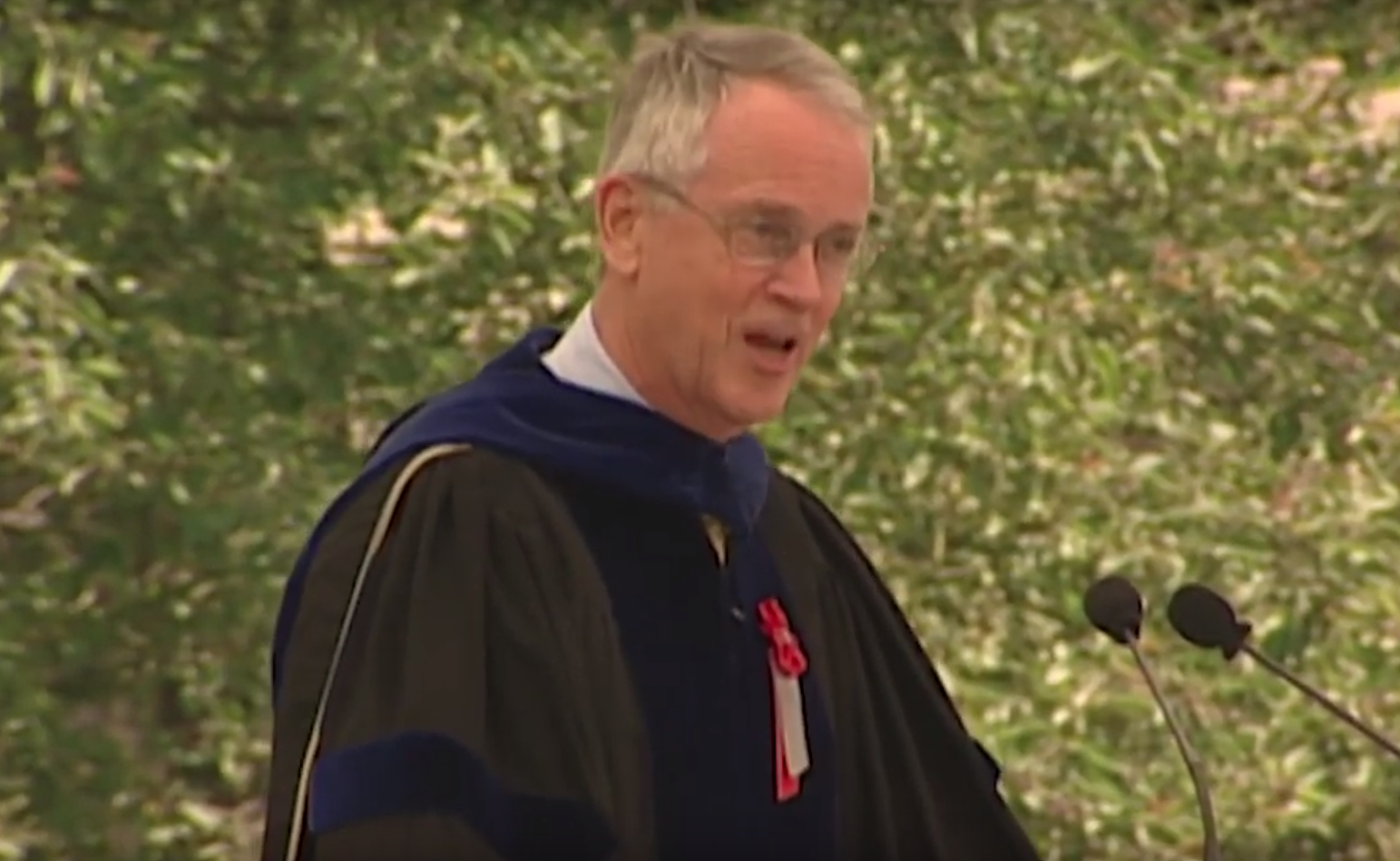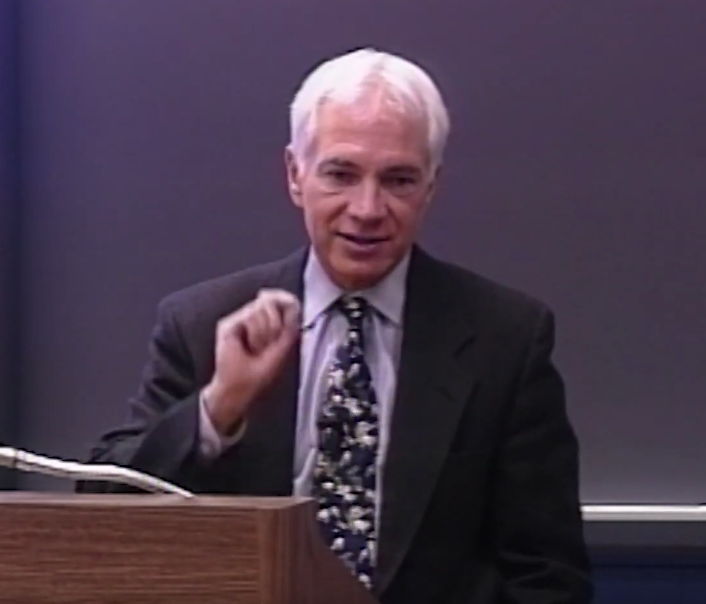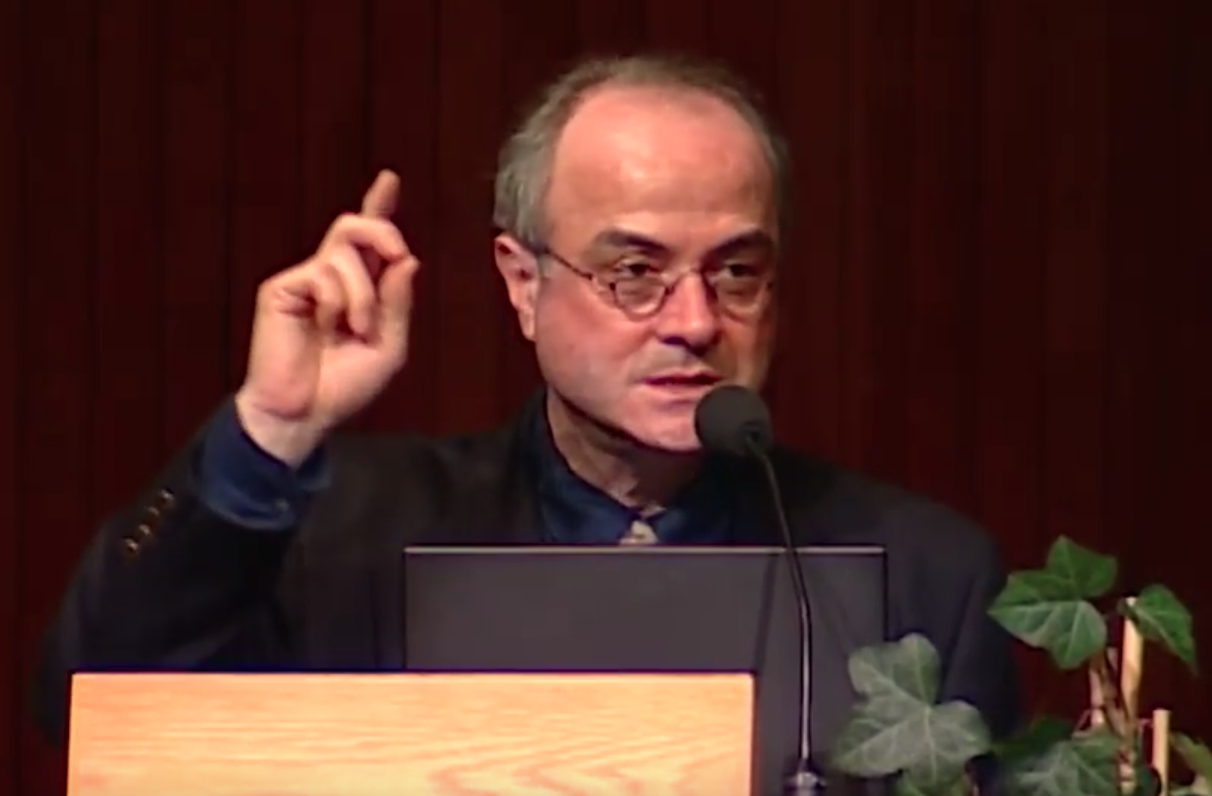Frank Wilczek,"The World's Numerical Recipe" - Pappalardo Distinguished Lecture in Physics 2001
[MUSIC PLAYING]
PRESENTER: Before I introduce today's speaker, I wanted to say a word or two about two great friends of the department, Neil and Jane Pappalardo. Five years ago or so, the MIT physics department realized that we had an opportunity to join a consortium to build two telescopes on a mountaintop in Chile. And we really wanted to do this and couldn't see any way to do it. Neil and Jane Pappalardo decided to help us do that.
And this December, Neil and Jane and 350 close friends gather together on the top of this mountain in Chile to have a celebration for the inauguration of the Magellan telescopes, truly magnificent instruments, state of the art telescopes which really put us in the vanguard of optical astronomy.
Then two years ago, Neil and Jane decided to help us create a distinguished post-doctoral program following the model of the Junior Fellows at Harvard. And we began this in the physics department. And now we have this year, for the first time, three Pappalardo Fellows. And there'll be another three joining us next September.
This is really a wonderful thing because over time, we hope it will grow into a program that spans the School of Science. Some of the other departments are already beginning to follow our example. So there are a couple of other Science Fellows. And this kind of program is wonderful because it gives the opportunity for brilliant young people to do something that they want to do that they think is interesting on their own, or in collaboration with other people at MIT.
So Neil and Jane have helped us in getting our hands on absolutely frontier technology, and also getting our hands on absolutely fantastic people. And those are the two things you need to do great science, and certainly in physics. You need great technology and great people. And so I'd like to just take a moment now to ask all of you to join me in thanking Neil and Jane for what they've done for us.
[APPLAUSE]
Now, speaking of great people who make great physics, it's time to introduce this year's distinguished Pappalardo lecturer. And you already have a nice little summary in here, which tells you a little bit about Frank Wilczek. Frank was just a kid when he and David Gross discovered asymptotic freedom. This is really a critical, a key aspect of our understanding of the strong force.
He's made great contributions, of course, to our understanding of the standard model, to cosmology, to condensed matter physics. So he is truly an unusually broad and deep physicist. Furthermore, he and his wife Betsy wrote a magnificent book on modern physics for the layman. And he writes these wonderful articles in Physics Today which really are very deep, and yet, at the same time, understandable.
Frank is interested in everything and he understands everything. So it's appropriate that he speak today about everything. It's all yours.
[APPLAUSE]
WILCZEK: Thank you. I like to think of Pythagoras as the first modern physicist. Certainly, he made one of the first discoveries of a physical law in the modern sense, and that is a quantitative-- no-- fact about observable realities of nature. It's a very beautiful law, and in a way, it's a law that, to this day, is not fully understood.
It's the law that the notes that we see as harmonious are the notes where the length of a string-- he was the first string theorist, also--
[LAUGHTER]
If you have different lengths of string of the same composition and under the same tension, then the strings will sound harmonious to our ears when plucked if and only if their lengths are in simple numerical ratios. So if the ratio of the length is 2 to 1, we'll hear them as being an octave. If it's 2 to 3, we'll hear a fifth. 4 to 3, a fourth, and so on.
Well, being a modern physicist, he was very impressed with his work, and generalized it to the principal that all things are number, that a complete description of the world should be based on numerical relationships. This is what I think of as the Pythagorean vision, or, in modern language, the idea that, as John Wheeler put it, you get its from bits. From purely conceptual information theoretic notions, if you like, you get a valid description of nature.
That idea was profoundly influential and inspiring to the followers of Pythagoras in physics, and especially in astrology. And one of the people who made great contributions, both to physics and astrology, was Johannes Kepler, who perhaps represented the apogee of Pythagorean thinking up until his day. We learn in physics textbooks about Kepler's three laws of planetary motion, the first, second, and third laws.
But less well known is that there was a zeroth law that he proposed that was the first law of planetary motion that he described, which is entirely fallacious, but which inspired his career and was very Pythagorean. His idea was that the different distances-- well, first of all, that the planets moved around the sun in circular orbits, and secondly, that the sizes of those orbits was fixed by circumscribing and inscribing the different regular solids.
So if I remember correctly, there's an icosahedron around the innermost sphere. And the sphere that carries Mercury is inscribed around that icosahedron. Then there's an octahedron then a dodecahedron. Then you can see the tetrahedron and the cube. And all these spheres rotated carrying the planets around them. And as they rotated, emitted musical notes, which Kepler even figured out.
[LAUGHTER]
Well, soon after, Kepler went from the zeroth law to the first law. And according to the first law of planetary motion, which he abstracted from the observational data of Tycho Brahe, the planets actually move around the sun in ellipses. So this beautiful construction was to his credit, immediately abandoned by him. And this kind of idea that the structure of matter in the universe was dictated by purely conceptual constructions like regular solids, went into an eclipse that lasted, really, for 250 years.
In Newtonian mechanics and classical mechanics, which replaced Kepler's early speculations, the orbits of the planets are largely arbitrary. If you take the sizes of the different orbits of the planets and a star came by our solar system, the orbits would all change and life would go on. In fact, now we've even observed extra solar planetary systems. And they don't necessarily look at all like our solar system.
In classical mechanics, and even in classical electrodynamics, this Pythagorean, Keplerian idea that the structure of matter is uniquely dictated by conceptual elements just doesn't hold. Technically it's because the equations of classical mechanics and also the equations of electrodynamics fix no particular scale of size.
If you take those equations and multiply all the distance scale by a constant, you get the same equations. So you map solutions into solutions. There can be nothing that fixes the size of particular materials, and certainly nothing that would lead to chemistry, to lead to atoms of different or materials of different types in different places in the universe being put together the same way.
And that's really the way it stood until the early part of the 20th century, when especially in the work of Niels Bohr, the Pythagorean and Keplerian ideas made a big comeback. Bohr's original atomic model was, in fact, based on an analogy to the solar system. It was based on 1 over r squared forces, electrical not gravitational, but satisfying mechanical equations.
But he added the extra element, very reminiscent of Kepler, that only certain sizes of orbits, only certain sizes orbits, actually occurred. But this time it's right, or at least a fair approximation. I'm looking for a pointer. Ah.
Okay. So you had different possible orbits and electrons in the atom could only orbit in one particular way. Then there was some kind of mysterious non-causal process where they could hop from one orbit to another. And you're not supposed to ask where they were in between.
By reasoning like this, which Einstein called the highest form of musicality in the sphere of thought, somehow referring back to the music of the spheres and the discrete relationships, Bohr got a successful description of the spectral lines and their frequency, which I've written down here as an equation. The details of the equations aren't so important for us. But I want to emphasize how closely the idea of capturing reality in terms of purely conceptual notions-- that is, ultimately numerical notions-- is realized in this formula for the spectral lines.
Almost everything in it, everything in blue here is a number. 4 is certainly a number. Pi is a number. c, the speed of light, well, that's an honorary number. Why do I say it's an honorary number? Well, in the theory of special relativity, which is a deep, foundational theory of physics, we have a symmetry between space and time. Transformations, symmetry transformations, that allow us to mix up space and time, the so-called Lorentz transformations.
But space and time are measured in different units. So we have to have some conversion factor that converts those physically identical objects, objects related by a symmetry, into the same units. And that's what this conversion factor does. So you should think of it as being like the three that converts yards into feet.
Similarly, h bar, Planck's constant, can be thought of as an honorary number because in the deep theory of quantum mechanics, there is a relationship between energy and frequency. The energy of oscillations is related-- the energy associated with an oscillation is related to the frequency at which it occurs in time.
But energy and time are measured in different units. We need a conversion factor. And that's Planck's constant. Okay. These n's are different numbers. They describe the different orbits. And then we have some things that are not numbers, whether honorary or actual. But there aren't very many of them.
There's alpha, the so-called fine structure constant, numerically equal to about 1/136, which describes the absolute strength with which protons and electrons attract one another. So this is just telling you about the strength of the electrical forces. And then we have a mass factor, mass of the electron times the mass of the proton, divided by the sum of the two. This is almost equal to just the mass of the electron because the mass of the proton is much bigger and almost cancels between numerator and denominator.
Okay, so that's hydrogen, and this physical spectrum of hydrogen reduced to almost purely conceptual numerical elements. In fact, it is reduced in a very good approximation, if we take the mass of the proton to be very large compared to the electron, to just two non-numerical elements, that is the mass of the electron and the fine structure constant. That's hydrogen. And hydrogen described in Bohr's provisional theory, or Bohr's theory, which was just a way station to modern quantum mechanics.
The successor theory to Bohr's theory of atoms, modern quantum mechanics, is based not on a picture of electrons as particles circling in orbits, but rather electrons as waves which oscillate up and down around the proton-- yes, oscillate up and down around the proton, which has captured them in different states of excitation. And this is a beautiful shareware program by Dean [? Dowager ?] which shows the different energy levels, the different stationary states of hydrogen, how the electron behaves in the modern analog of these different orbitals. It's Mac only.
[LAUGHTER]
And it's a beautiful thing. In fact, it also allows you to play microcosmic God. You can grab the atom and spin it around. You can-- well, fortunately, what I see on my screen is much better than what you see. You can spin it around. You can make different transitions. So here let's transit down there. See, that's this line here.
And this is the real thing. This is actually being computed in real time. This is what electrons actually do. This is what we're made out of. This is our most accurate description of atomic nature. And it only depends-- all this only-- this is hydrogen. If you also go to more complicated atoms, if you go to molecules, all you need is the mass of the electron and alpha. So those are the two first ingredients in our numerical recipe for nature.
So by 1930 or so, modern quantum mechanics was in place. And attention switched to describing those atomic nuclei, the protons and the more complicated atomic nuclei in bigger atoms. Well, first of all, I showed you the wave atoms. And I think you'll agree, you get a lot of structure and a lot of physics out of just these two numbers.
But this was approximate. We had to neglect or take the mass of the proton to infinity. And similarly, we'd have to put in from experiment the masses of other nuclei if we wanted to really account for matter in full accuracy. So it's only an approximate recipe for nature, even for ordinary matter. And the attention of physicists starting in 1930 or so switched or began to focus on doing justice to those atomic nuclei inside.
The first great breakthrough in understanding that was the discovery by Chadwick in 1932 of the neutron and the swift emergence of the modern picture that nuclei are basically weakly bound assemblages of protons and neutrons. But then it emerged-- and in this development, crucial experiments were done by Friedman, Kendall, and Taylor in an MIT collaboration-- that protons had internal structure, that they're not simple objects, but are assembled out of some kind of simpler structure.
And then, in a complicated history, which fortunately has an outcome that's much simpler to describe than the history, we arrived at the modern understanding of what holds protons and neutrons-- what protons and neutrons are made out of, what holds them together, and what holds more complicated atomic nuclei together. This theory is called quantum chromodynamics, or QCD.
In quantum chromodynamics or QCD, we describe the stuff that makes protons in terms of two different flavors of quarks, the U and the D quarks, each of which comes in three so-called colors. They're actually red, white, and blue. But the white was not suitable for the transparency. So you should imagine that these are white quarks. And a bunch of gluons.
Now, these are just symbols. And clearly, I'm just joking when I say that they're colored. What this color really means is not, of course, the color you would see it of physical light of these quarks. Color is actually a generalization of electromagnetic charge. It's more to be thought of as a charge. QCD is a generalization, a vast generalization, of quantum electrodynamics, of the theory of electrical and magnetic forces. Whereas electrical and magnetic forces are based on electric charge, these are based on the three kinds of charges, all different, red, white, and blue.
And the gluons are the analog of the photons of electromagnetism that allow-- that respond to these charges. The big difference between QCD and QED, the big difference that comes from having three colors instead of one, is that gluons-- which can change one kind of color quark into another by carrying off, say, the green-- excuse me, white-- color and carrying in a red color, thus changing the green one, the white one, to the red one-- themselves have unbalanced color charge.
See, something that does that has not zero charge, as it would be if you had just one electric charge or you changed an electric charge into an electric charge of the same value. The photon has zero charge that it carries off. Charge is conserved. Here, if you change one color into another, the gluons have unbalanced charge. It has one unit of green charge-- white charge-- and minus one unit of red charge.
So the gluons themselves carry the color charge which licenses you to draw the Mercedes-Benz diagram, where gluons which respond to color-- that's what they care about-- interact with each other. Many of you have probably seen Star Wars and remember the laser swordfights. Well, laser swordfights would actually be very tedious affairs because if you use photons, they'd just wave through each other. Any of you who've worked in a laser lab probably haven't noticed lasers clinking against-- laser light clinking against each other when they happened to cross.
Of course, it's a movie about a different galaxy in the future. I conjecture that they're using color lasers with gluons. Then something dramatic would happen. I'm not sure exactly what, but there would be quite a bang. Anyway, this changes the equations, it makes them much more difficult to solve and leads to many, many fascinating phenomena that I won't be able to do justice to, of course, in this reflector. I'm not even doing justice to them in my QCD course this semester.
But among the rest, it can be thought of as mediating forces similar to electromagnetic forces that cause quarks to attract one another, similarly to the way that electrons and protons attract and bind each other into atoms. Systems of quarks can attract and bind each other into other kinds of particles.
Well, that's a very imaginative picture, you may say. How do we know that it's correct? And how do we make it quantitative? Well, the key is symmetry. Well, the key is analogy and symmetry. As I've told you, there are deep analogies between how gluons interact with color charges and how photons interact with electromagnetic charges. And in fact, we just steal the equations from electrodynamics and use basically the same equations in this context, with the modification that we have this Mercedes-Benz process.
So we know exactly what the form of the interactions is. And it's postulated to be perfect symmetry among all the different colors. So there's no arbitrariness in how strongly one kind of quark interacts with another. Every single allowed process occurs with a definitely determined strength. And we have absolutely unambiguous predictions of the theory, if we can just manage to do the calculations.
And after something like 10 to the 18th floating point operations, you can calculate with only fundamental microscopic input the masses of protons and neutrons-- those are called nucleons on this plot-- and a whole lot of other particles made out of just the up and down quarks, the gluons that appear in the strong interaction, and there's also another quark that doesn't occur in ordinary matter, but I left it in here to have a bigger diagram with more things to compare-- the strange quark.
So these black horizontal lines-- so we're plotting here just different kinds of particles, and here their masses. The experimentally observed masses are these horizontal lines. And the calculated masses with-- and this is the profound point I want to emphasize-- no input except purely conceptual input, the nature of the theory and its symmetries, and two mass parameters for the up and down quarks, and if we want to do strange quarks, one more mass parameter. This is all output.
So you compute the masses of the particles here with 10% accuracy in terms of very, very few parameters. By the way, there are later calculations that are beginning to nibble away at that 10%. And there's every reason to think that the agreement will be precise. Maybe you have to do 10 to the 20th floating point operations instead of 10 to the 18th to get there.
Underlying this, these calculations, is a vast generalization of those beautiful pictures of the different states of atoms being waves oscillating in space. All these different particles consist of quarks, either three quarks or a quark and an anti-quark, oscillating, making wave patterns like that. So they're oscillating in the same way as electrons, but also oscillating in an extra three dimensional color space. The different colors getting mixed up. It really taxes the imagination to try to think of all this.
But if you liked those pictures of hydrogen, and if you have a lot of imagination, you would love what protons look like. And in a very precise sense, the different kinds of particles are made up of-- the different kinds of particles we observe in nature are made out of quarks and gluons oscillating in different ways with the different waves beating against each other in stable patterns. The different stable patterns are what makes the different particles we observe.
They are, in a very precise sense, like the tones that the vacuum can sound, that space can sound. Space can produce these particles and they interact with each other in certain stable ways. That's exactly how we get tones from a musical instrument. And it's even similar equations, with waves oscillating in space.
So we get a lot from very little. In fact, the more you look at this, the more impressive it is because the mass of the gluon is taken to be 0, not for convenience, but because the symmetry of the theory requires that the mass of the gluon be rigorously 0. And you notice that the mass of the up and the down quarks in these units isn't making a negligible contribution to the mass of most of these particles, certainly to the proton.
The mass of the proton is about 1 in these units, 1 GEV. The mass of the things that are in it is contributing almost nothing to that. The mass of the proton doesn't come from its being made out of heavy objects. It comes from the fact that these objects are being bound together by attractive forces. They're are trying to pull away because they're waves and they want quantum mechanically to just dissipate away. But there are forces pulling them back. And so there's energy in the oscillations, the pull and tug between the forces and the quantum mechanical uncertainty.
And when you have energy, according to a slight modification of Einstein's familiar equation-- not e equals mc squared, but m equals e divided by e squared-- you can turn pure energy into mass. And that's, in fact, the source of most of the mass in the universe. So really, to do a really good job on ordinary matter, you need you mu, md, and apparently some analog of the fine structure constant that tells you how strongly the gluons couple, just how numerically powerful the force is.
But actually, two of these masses are almost insignificant, quantitatively. One sign of that is that I didn't show arrows here. Experimentally, they're not really known to within better than a factor of two, even though they're the most fundamental constituents of matter that have mass. But it's even better than that.
So so far we've gotten a description of nature, of ordinary matter in terms of five parameters. We had the mass of the electron, the fine structure constant, and then we have two that don't matter very much, the masses of the up and down quarks, and apparently the fine structure constant, the analog of the fine structure constant that tells us exactly how strong the interaction between quarks and gluons is.
But now we come to another crucial, beautiful aspect of QCD, which is that the strength of the interaction depends on the distance at which you measure it. This is due to the fact that in the quantum mechanical theory, you have virtual particles which come to be and pass away. And what we see as empty space is actually a dynamical medium that can screen charges and affect how charges at great distances see each other. They don't see each other directly, but they see each other as modified by the intervening medium.
So the strength of the interaction depends on the distance. It's easier, for technical reasons, to measure how the probability of radiation varies as you change energy. But theoretically, that's the same-- or the inverse, rather-- of how the force changes with the distance. And here experimentally you see a tremendous variety of experiments indicating that as you go to higher energies, the probability of radiating gluons goes down, indicating that the force is getting weaker at large energies or equivalently at small distances.
Or put another way, the force grows as the distance increases, which is an explanation of why quarks can't get very far away from each other. In any case, from our sort of philosophical point of perspective of seeing exactly how much it takes to describe the world, the important phenomenon is that we can eliminate one of the numbers. And we've gotten down to five. Every step down is a significant step.
So we've simplified the description of the world by 20% because we don't have to specify a fine structure constant for the strong interaction. We don't have to specify how strong it is. It can be any strength you want. The strength varies with the distance. So I can trade the strength of the coupling for a measure of distance.
So the strength of the coupling is not an independent parameter in some sense-- well, in this sense. It's simply telling you how to measure the scale of energy or distance because any value of the coupling is actually realized that some energy or distance.
So we've gotten mass without mass, which tells us that out of the three apparent non-conceptual elements of QCD, two of them are pretty insignificant. And then a third one is absolutely insignificant. It can be defined away. So we've gotten a great deal the whole structure of protons and neutrons and the masses of nuclei practically from pure concepts from nothing at all.
But to be accurate, now our numerical recipe contains four elements, the mass of the electron, the fine structure constant, and the masses of the up and down quarks. And this gives us a superbly accurate description of ordinary matter. It tells us why the thing we call hydrogen exists and looks like hydrogen and has all its properties, why water is what it is in principle.
Of course, none of this we can compute. Because of experiments like the ones I alluded to, the fundamental interactions that we can compute, we have great confidence that the underlying theory is sound.
Well, that and this. Now, I want to put in a plug for physics not being over. There's been a lot of-- there is a tendency to talk loosely about the theory of everything. And it should be understood that that's a term of art that has a very specific meaning. In that sense, I think we do have a theory of everything about ordinary matter. We have a very precise theory with algorithms only a very, very small number of parameters, which I showed you, which I think is going to be our working description of matter for a very long time, and probably forever.
Does that mean we have a theory of everything for ordinary matter? No, of course not, because what it really means is that we have nothing more to tell chemists or biologists or something, that everything we're ever going to tell them, we've already told them. And there's a tremendous challenge and a tremendous opportunity to take the fundamentally simple laws and build up a description of nature that really does justice to the complexity and the richness of real matter.
Now we know what the rules are, we can try to be designers. Some of us heard a brilliant talk at lunchtime today by Professor Joe [? Annopolis, ?] who's crafting ways based on the fundamental laws of physics to move light around. And that's an example of exploiting our knowledge, our hard won knowledge, and an example of how having the fundamental laws, in many ways, is not the end but the beginning of challenging problems in physics.
Okay, so much for ordinary matter. We have a quite economical description of ordinary matter that I think Pythagoras would have been very pleased with. Now let's get a little more ambitious and try to do astrophysics, as well. To do astrophysics, I claim we need just two more parameters.
One class of processes that's very important in astrophysics are the processes that cause stars to burn. And those are the weak processes. At a fundamental level, they're described in terms of the possibility of down quarks turning into up quarks plus electrons plus anti neutrinos. Or actually, this is the process of beta decay. It's closely related. You just bend around the lines and you get the processes that are responsible for stellar burning.
So this, although it just looks like a silly picture, to a physicist who knows about relativistic quantum field theory, which has very, very rigid rules, is actually associated with a complete and unambiguous description of the weak interactions. And all we need to add to our numerical recipe is one parameter which tells us about how big this process is, how rapidly it occurs over a one overall new constant. And that's called the Fermi constant, G sub f.
And then for astrophysics, the other thing that's very important that we haven't mentioned so far is gravity. Gravity, you might think, is, since it's so obvious, must be a very powerful force, and we've been silly to be neglecting it so far. However, at a fundamental level, gravity is actually extravagantly feeble. It only wins in astrophysics by default.
If you, for instance, compare the strength of the attraction between a proton and electron due to their electrical interaction, which goes like 1 over r squared, to their gravitational attraction, which also goes like 1 over r-squared, you'll find that the electric attraction is about 40 orders of magnitude larger, one followed by 40 zeros. An extraordinarily large number.
Physicists like to put it in terms of something called the hierarchy problem to make it quantitative. If we want a quantitative measure of how strong gravity is fundamentally, well, we have to ask, compared to what? And since most of the mass of matter is made in protons, we have to construct a dimensionless quantity, a pure number, out of the honorary numbers, Newton's constant and the mass of the proton.
And that can be done in one and only one way. And it gives a number, 10 to the minus 38, that tells us that gravity in any natural sense, in a fundamental sense, is an extravagantly feeble force. It can dominate in astrophysics because the other, more powerful forces, being more powerful, rearrange matter in such a way as to cancel each other out to reach equilibrium and neutrality. But gravity keeps adding up, and eventually, on large enough scale, wins out.
Now previously I said that Planck's constant, h bar, and the speed of light, c, should be thought of as honorary numbers because in profound theories of nature, they occur as conversion factors. Now I'd like to argue that Newton's constant that governs the strength of gravity is also an honorary number. That's because it's associated with the profound theory of general relativity as a conversion factor.
In general relativity, there is a relationship between the curvature of space time and the energy density of matter. But those have different units. The curvature of space-time has different units from the energy of density-- density of matter. We need a conversion factor to relate them. And that conversion factor turns out to be Newton's constant.
So if we think that Gn is an honorary number, the question posed by this extravagantly weakness of gravity gets viewed in a totally different way. G Newton is not small. It just is what it is. It's a conversion-- it's a primary number. It's a conversion factor. h bar and c, all of them are honorary numbers. They just are what they are. There's no way of them being either large or small.
So the real question is, why is the proton mass so light? Why is the proton so light? Well, why is the proton so light? Well, earlier in the lecture, I told you how the proton gets its mass. So we can address the question, why is the proton so light?
And the answer is that you must walk before you run. Well, that, I think, probably sounds very cryptic to most of you. So let me explain it better. As I discussed, the strength of the interaction with which quarks attract each other depends on the distance. And the dependence is something that we can predict theoretically, and has also been measured in a variety of experiments, up to energies of 100 GEV.
We can extrapolate all the way to the fundamental energy, which, if we believe that Newton's constant is a honorary number, we can identify as 10 to the 19th proton masses, or 10 to the 19th GEV, way out here somewhere. And the thing that governs the mass of the proton is that at these distances out here, at the fundamental distances, the forces are too weak for quarks to keep them locked to each other. It has to build up.
But the coupling due to quantum mechanical fluctuations that we talked about, the screening effect, only changes very, very slowly at first, until a cloud of charge builds up and gets bigger and bigger. So it's walking. It's actually sort of limping along like a wounded snail for a long time, until it slowly builds up. And then finally, at, of course, not coincidentally, a length corresponding to the mass of the proton, it becomes strong enough to bind the quarks together.
That's why protons are so light in natural units. It comes about because the coupling was a little bit small at the fundamental scale. And given that it's a little bit small, it takes a long, long time for the small quantum mechanical effects to build up and make it big and eventually bind protons-- bind quarks into protons.
Now, as I said, so now we've introduced-- we have a description of matter which is a very accurate description, including both ordinary matter and astrophysics, based on six quantities-- the fine structure constant, the mass of the electron, the masses of the up and down quarks, the Newton constant, and the Fermi constant. They're the things that appear in red on your program.
But I've just been trying to actually improve. I said each time you make an improvement on that, you're making a major contribution to physics. So I've just been trying to implement the idea, if you like, or discuss the idea that Planck's constant, too, should be regarded as an honorary number. And we scored a significant success for that point of view by explaining how the proton could be so absurdly light measured in those natural units, or putting it another way, why gravity is so feeble.
Now, if that explanation-- if we're going to succeed in actually promoting the Newton constant to an honorary number and reduce our numerical recipe, it has to work not only for QCD, but also for the other interactions in the world. Or let me put it another way. We would like to see that same scale, that Newton constant, emerge in some other way in physics that's independent of the theory of gravity.
Well, remarkably enough, there is another way in which the Newton constant emerges from quite different considerations in our fundamental theories of physics. As I told you, the couplings change with distance very, very slowly. Here, to make the plot look simple and be able to fit it on one little sheet, we've switched to a logarithmic scale and plotted inverse couplings instead of couplings.
And I have here the fine structure constant for QCD, the fine structure constant for electrodynamics, and an analogous thing that occurs in the weak interactions that I haven't described, but is something that is important in particle physics. And you can ask if all these different interactions that we see at low energies might be different manifestations of a unified theory that is simple in its operations at short distances, but gets obscured from us by these same quantum mechanical fluctuations and screening effects that make the couplings change with distance.
So operationally, we have to take these guys from experiment-- that's where we measure them-- and then theoretically calculate what the effect of the screening is to see if they could have derived from a unified theory. And remarkably enough, the measured values are consistent with their emerging from a unified theory where they all become equal and all become different facets of one interaction. And that occurs at an energy that's very similar to the energy we extract, the Planck scale we extract, from Newton's constant, this 10 to the 19th GEV.
So if we ask, could there be a unified theory of matter, we get the resounding answer that yes, not only could there be, but there's a strong indication that the very different looking interactions we see at low energies are all facets of one unified theory at high energies. And if we do further experiments, further discoveries-- including the existence of neutrino mass, which, in its details, supports the idea of such unified theories-- the unified theories also predict that protons should decay. That one hasn't been observed yet.
So we get two exclamation points and a question mark to our question, is there a unified theory of matter that congeals at something close to this Planck scale. But then the final step must be to bring back in gravity. Well, gravity is also sensitive to the energy at which you measure, and not just because of subtle quantum mechanical effects, but because gravity just cares about energy. The gravitational force is proportional to mass or energy, according to e equals mc squared.
So the higher the energy, the stronger gravity appears relative to the other interactions. And so the inverse coupling of gravity on this logarithmic scale happens to look like that. And you can see that gravity also seems to be joining the other interactions. We can't do this calculation very accurately, but to the accuracy that it deserves, it's consistent with the idea that all these interactions unite together.
So the basic idea that Newton's constant can be regarded as an honorary number, and should be the fundamental mass that appears in the fundamental unified theory, holds up very well from two very different perspectives. It's the scale at which there's independent indication of a fundamental theory of emerging of the non-gravitational forces. And it's also the scale at which gravity meets those and potentially a fully unified theory that includes not just a theory of matter, but also the theory of space and time, which is what gravity is in Einstein's general relativity theory.
So to the question, do these considerations of the numerical recipe for nature point us toward a unified theory of space-time matter, this one does. But really, that's the only quantitative indication so far along those lines. And there are big puzzles in trying to construct a unified theory with gravity and the other interactions. There's the puzzle of why empty space doesn't weigh anything. And there's just the puzzle that we don't have any very concrete theory along these lines.
There are the germs of ideas coming from string theory that perhaps will congeal into a well-defined theory. But at present, it's kind of a vague assemblage of ideas. So let me summarize. To construct ordinary matter, to construct a description of ordinary matter that's extremely precise and very well verified, we were able to get by with a couple of honorary numbers, h bar and c, and four non-numerical quantities, exactly four-- the mass of the electron, the fine structure constant, and the masses of the ups and down quarks.
And among those, the masses of the up quarks and down quarks didn't matter very much quantitatively. If we want to do astrophysics as well, we needed to add just two more numbers-- the Fermi constant describing the weak interactions and the Newton's constant describing the strength of gravity. And then finally, I gave you a series of arguments sort of at the frontiers of physics indicating that the idea that we can treat Newton's constant also as an honorary number is becoming very, very plausible.
We get at that number from considering unified theories of the other interactions and how they emerge. We get a convincing explanation of why gravity is so feeble based on interpreting it as actually the lightness of protons-- which in turn was interpreted as the coupling having to walk before it runs-- and then finally from the just straight calculation of whether gravity unifies with the other interactions.
So the Pythagorean vision that the world can be described in terms of pure numbers is very, very close to being realized in a very concrete and beautiful way that I hope I've given you some inkling of. Thank you.
[APPLAUSE]
PRESENTER: I'm sure Frank will answer questions.
WILCZEK: Yes.
AUDIENCE: Thanks. Since you talked about [INAUDIBLE] very troublesome [INAUDIBLE] We have no theoretical explanation or description. And that area of physics [INAUDIBLE] to what you called very briefly [INAUDIBLE]?
WILCZEK: Well, yes. I tried to dissociate myself very carefully from the philosophy, if you want to call it that, that in physics, you're done once you write down the equations. It's an important part of physics to write down the equations. But to really be able to solve them in meaningful circumstances, to be able to do them justice, to relate them to the world, is a tremendous art, and every bit as important and challenging as finding the equations. Yes.
AUDIENCE: Electron has a charge and the quarks have charges of one third and 2/3 and they exactly match, how does that come out of your [INAUDIBLE]?
WILCZEK: Oh, well that does actually come out of-- so the question was, if you actually look in detail at some of the properties of our quarks and electrons, they're a little funny. For instance, the electric charge of the up quark has to be 2/3 the electric charge of-- or minus 2/3 the electric charge of the electron. And the electric charge of the down quark is one third the electric charge of the electron.
Where did these funny numbers like 2/3 and one third come from? Well, first of all, since they're numbers, they're not anti-Pythagorean. But secondly, and more seriously, they are among the most-- I haven't been able to do it justice. And I won't be able to do it justice in this brief lecture. But they emerge in a very compelling way from these unified theories. Let's see, how can I say this in a simple way? You see-- yeah.
The physical photon, as we observe it, is some mixture of the gluons in the fundamental theory. And so are the gluons of the strong interaction. They are mixtures. And which particular mixtures emerge as the photon and emerge as the color gluons is determined by the details of how this symmetry breaks, of how the big symmetry of the original underlying theory breaks. So to address questions like the relative charges of different objects, we need to be specific about what this theory was, and about how the original, highly symmetrical theory broke down into the less symmetrical theories we actually see at low energies.
I can be a little bit more specific about this and give you some idea of how it works. But to really do it would require some equations. I emphasized that the theory of electrodynamics was based on very similar concepts to the theory of QCD. They were both based on different kinds of charges, also called colors, and their transformations and interactions with photons or gluons. The form of this unified theory-- oh, and I should say, the theory of the weak interaction is based on a similar idea involving two other colors.
So all these theories are different kinds of-- theories of different kinds of charges interacting with different kinds of gluons. The unified theory is simply including all possible transformations among all the colors-- strong, weak, and electromagnetic-- and seeing if they can be incorporated on equal footing. And the calculation here shows that that idea succeeds. Then you have to discuss, well, why isn't the world-- why in the real world don't we see all these interactions on an equal footing? What happened?
And that's the subject-- the phenomenon is called spontaneous symmetry breaking. And it will sound poetic, but it's literally the case that what's involved here is the concept that the whole world is a multi-layered, multicolored superconductor. Ordinary superconductors are governed by the concept that you have so-called Cooper pairs of electrons, pairing up and filling a metal and giving a photon a mass and effecting the properties of photons, effectively giving photons a mass inside superconductors.
In these theories, what we need is not pairs of electrons, as in superconductors, but pairs of similar things carrying other kinds of color charges, filling what we think of as empty space. But of course, it's not empty. It's a multi-layered, multicolored superconductor because it has these pairs. It's filled chock-a-block with pairs of particles with different colors. And it's the presence of that medium that distinguishes the different colors between strong electromagnetic and weak.
Say these pairs have more-- are more aligned in the direction of the weak interaction than the strong interaction, and that distinguishes the two directions and breaks the symmetry. Well, I'm trying to say something that's easier done than said. But the-- well, maybe I'm giving you some sense that it's the details of how this symmetry is broken that determines the charges at the end of the day. And if you take sort of the simplest possibilities for how this symmetry is broken, that's what gives you the structures we observe at low energies, including things like the charge 2/3 and one third on the quarks that otherwise seem so funny. Yeah.
AUDIENCE: It seems that you're being [INAUDIBLE] the question I had since the early slide when you were showing the pairs. There are paired reds, paired blues, but no green pair on that slide. Is that
[INTERPOSING VOICES]
WILCZEK: Gluons? Oh, yes. Well, yeah, totally unorganized.
[LAUGHTER]
So you might think, if we have gluons that change any possible color into any other color, including the same one, that there would be nine possibilities, three times three. And there are, of course. But one of those colored gluons, well, the joke I might like to make is that these are gauge bosons. But one of them is a gauge bogon. It's bogus.
There's one that's different from all the rest. And it's composed of an equal combination of the red, anti-red, blue, anti-blue, and white, anti-white, or green, anti-green. In quantum mechanics, you are allowed to take linear combinations of these different possibilities. And the gluon which treats all those colors symmetrically obviously has different properties than any of these other guys which don't treat the different colors symmetrically.
If you know a little group theory, if you take a product of a triplet and an anti-triplet representation of color, which is what we have here, they form an octet, eight gluons, which is perfectly symmetrical, and a singlet, which has different properties. So in the theory of the strong interaction, that singlet doesn't participate. It's different from the rest. And so to enforce the proper symmetry of the strong interaction and agree with nature, it's consistent and necessary to throw it out.
So actually, it's a slight lie-- well, it's a big lie-- to just leave out the green, anti-green. What I should have written here was red, anti-red minus blue, anti-blue and something like blue, anti-blue minus green, anti-green. Then it would have been mathematically correct but probably even more confusing. Yes.
AUDIENCE: Your graph of the various [INAUDIBLE] versus energy, it looks on the low energy side as if you're changing the fine structure constant by a few percent every decade.
WILCZEK: This is-- wait, wait. This one. This one?
AUDIENCE: No, you had the quark, the three different coupling constants.
WILCZEK: Yes.
AUDIENCE: The straight and the gravity was [INAUDIBLE].
WILCZEK: Right.
AUDIENCE: So if I just extrapolate that down a few more orders of magnitude, then I raise the question, why do I see nine decimal places, the same fine structure constant in hydrogen and in singly ionized helium?
WILCZEK: You don't. I mean, when you do accurate calculations of the force between, say, electrons-- between an electron and a positron or whatever, I guess you find that the force does change logarithmically. This is the Uehling effect or vacuum polarization which appears in atomic physics. So--
AUDIENCE: I'm aware of that, but it's a whole lot flatter and straight per decade so something must be happening is my question.
WILCZEK: Yeah. Well, these calculations are done basically neglecting the masses of particles relative to the energy. And that's valid for all the particles we know about sort of from here on out. But it would be totally invalid.
AUDIENCE: So they flatten out?
WILCZEK: Yeah, they flatten out. Well, they flatten out in these two cases. In this case, well, it's not exactly known. It becomes a strong coupling problem. And it's not really well-defined. But anyway, yeah, you can't just extrapolate these curves. That's quite right. Yes.
AUDIENCE: If we use this slide and the convergence of these curves to sort of try to dub a couple of your constants into honorary numbers--
WILCZEK: Just [INAUDIBLE].
AUDIENCE: Okay. But don't you get if you--
WILCZEK: So the question is, can-- well, go ahead. Ask your question.
[LAUGHTER]
I'll ask the question you should be asking.
AUDIENCE: I guess what I mean is I have a feeling that you've somehow got one more honorary than you're really entitled to. I mean, for instance, alpha s, you turned that into an honorary number by saying, well, really, lambda QCD just sets the length scale. It's sort of the natural unit of length. But then the Planck length you're trying to tell me is the natural unit of length. I mean, can't you only use one--
WILCZEK: Yes, I did do somewhat of a sleight of hand here. If I make the Planck length the scale of length and run through my explanation of why gravity is feeble or why protons are so light, that explanation required knowing what the value of alpha s was at the Planck length. So if I do it that way, I reintroduce a numerical parameter. So you're quite right, yes. Yeah.
AUDIENCE: I'm actually speaking with the voice of Pythagoras. If you can show me your Pythagoras thing, we have noticed that you have an error in your numerical table.
WILCZEK: Oh, is that?
AUDIENCE: You could leave it as an exercise for the audience to figure out what the error is.
WILCZEK: Okay.
AUDIENCE: The error is that the ratio of e to c is actually, I worked it out here, 81 to 64. Any violinist understands that.
WILCZEK: Oh, well.
[LAUGHTER]
[INTERPOSING VOICES]
AUDIENCE: It is a terrible scale because everything sounds dissonant. [INAUDIBLE].
WILCZEK: I believe it's the scale that Pythagoras used.
AUDIENCE: No, it's not. It's not. No. The ratio of e to c is 81 to 64.
WILCZEK: You mean a to the gap? Well, I don't know. Okay.
AUDIENCE: It's a music thing.
WILCZEK: I don't know this history. But--
AUDIENCE: If you can find a hint related to it, [INAUDIBLE] where you'll find that the magic ratio God made when he made the world, the ratio was 256 to 243. [INAUDIBLE]
WILCZEK: All right. Well, for those of you who didn't catch this, let me just remark that 81 divided by 64 is very close to five.
[LAUGHTER]
PRESENTER: On that note, I think we should thank Frank again for--
[APPLAUSE]

